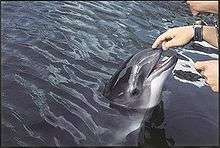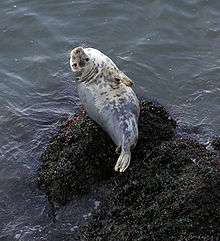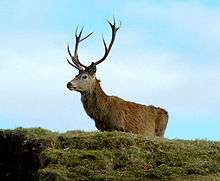List of mammals of Ireland
This is a list of the mammal species recorded in Ireland. There are 60 mammal species in Ireland. A new Red List of Irish terrestrial mammals was published in 2009 and all 26 terrestrial species native to Ireland, or naturalised in Ireland before 1500, were assessed. Of these, one was found to be regionally extinct (grey wolf Canis lupus), one achieved a threat status of Vulnerable (black rat Rattus rattus), three were found to be Near Threatened (Leisler's bat Nyctalus leisleri), otter (Lutra lutra) and red squirrel (Sciurus vulgaris)), one was data deficient (Brandt’s bat Myotis brandtii) and the remaining 20 were of least concern.[1]
The following tag are used to highlight each species' conservation status as assessed by the IUCN:
| EX | Extinct | No reasonable doubt that the last individual has died. |
| EW | Extinct in the wild | Known only to survive in captivity or as a naturalized populations well outside its previous range. |
| RE | Regionally Extinct | The species is extinct in the wild in the region. |
| CR | Critically Endangered | The species is in imminent risk of extinction in the wild. At this point, action is taken to preserve the habitat. |
| EN | Endangered | The species is facing an extremely high risk of extinction in the wild. |
| VU | Vulnerable | The species is facing a high risk of extinction in the wild. |
| NT | Near Threatened | The species does not meet any of the criteria that would categorise it as risking extinction but it is likely to do so in the future. |
| LC | Least Concern | There are no current identifiable risks to the species. |
| DD | Data Deficient | There is inadequate information to make an assessment of the risks to this species. |
Subclass: Theria
Infraclass: Eutheria
Order: Rodentia (rodents)
Rodents make up the largest order of mammals, with over 40 percent of mammalian species. They have two incisors in the upper and lower jaw which grow continually and must be keep short by gnawing. Most rodents are small though the capybara can weigh up to 45 kg (100 lb).
- Suborder: Sciurognathi
- Family: Sciuridae (squirrels)
- Subfamily: Sciurinae
- Genus: Sciurus
- Red squirrel Sciurus vulgaris NT.
- Eastern grey squirrel Sciurus carolinensis not assessed - a recent introduction in 1911.
- Genus: Sciurus
- Subfamily: Sciurinae
- Family: Cricetidae
- Subfamily: Arvicolinae
- Family: Muridae (mice, rats, etc.)
- Subfamily: Murinae
- Genus: Mus
- House mouse Mus musculus LC. Very early introduction.
- Genus: Apodemus
- Wood mouse Apodemus sylvaticus LC.
- Genus: Rattus
- Genus: Mus
- Subfamily: Murinae
- Family: Gliridae
- Subfamily: Leithiinae
- Genus: Muscardinus
- Hazel dormouse Muscardinus avellanarius - not assessed; a recent introduction (confirmed 2013).[2]
- Genus: Muscardinus
- Subfamily: Leithiinae
- Family: Sciuridae (squirrels)
Order: Lagomorpha (lagomorphs)
The lagomorphs comprise two families, Leporidae (hares and rabbits), and Ochotonidae (pikas). Though they can resemble rodents, and were classified as a superfamily in that order until the early 20th century, they have since been considered a separate order. They differ from rodents in a number of physical characteristics, such as having four incisors in the upper jaw rather than two.
- Family: Leporidae (rabbits, hares)
- Genus: Oryctolagus
- European rabbit Oryctolagus cuniculus LC - an early introduction c. 12th century.
- Genus: Lepus
- Irish hare Lepus timidus LC.
- European hare Lepus europaeus - not assessed; recent introduction.
- Genus: Oryctolagus
Order: Erinaceomorpha (hedgehogs and gymnures)
The order Erinaceomorpha contains a single family, Erinaceidae, which comprise the hedgehogs and gymnures. The hedgehogs are easily recognised by their spines while gymnures look more like large rats.
- Family: Erinaceidae (hedgehogs)
- Subfamily: Erinaceinae
- Genus: Erinaceus
- West European hedgehog Erinaceus europaeus LC.
- Genus: Erinaceus
- Subfamily: Erinaceinae
Order: Soricomorpha (shrews, moles, and solenodons)
The "shrew-forms" are insectivorous mammals. The shrews and solenodons closely resemble mice while the moles are stout-bodied burrowers.
- Family: Soricidae (shrews)
- Subfamily: Soricinae
- Genus: Sorex
- Eurasian pygmy shrew Sorex minutus LC.
- Genus: Crocidura
- Greater white-toothed shrew Crocidura russula, not assessed, a very recent introduction.[3]
- Genus: Sorex
- Subfamily: Soricinae
Order: Chiroptera (bats)
The bats' most distinguishing feature is that their forelimbs are developed as wings, making them the only mammals in the world naturally capable of flight. Bat species account for about 20% of all mammals.
- Family: Vespertilionidae
- Subfamily: Myotinae
- Genus: Myotis
- Daubenton's bat Myotis daubentonii LC.
- Whiskered bat Myotis mystacinus LC.
- Brandt's bat Myotis brandti DD.
- Natterer's bat Myotis nattereri LC.
- Genus: Myotis
- Subfamily: Vespertilioninae
- Genus: Nyctalus
- Leisler's bat Nyctalus leisleri NT.
- Genus: Pipistrellus
- Common pipistrelle Pipistrellus pipistrellus LC.
- Soprano pipistrelle Pipistrellus pygmaeus LC.
- Nathusius pipistrelle Pipistrellus nathusii LC.
- Genus: Plecotus
- Brown long-eared bat Plecotus auritus LC.
- Genus: Nyctalus
- Subfamily: Myotinae
- Family: Rhinolophidae
- Subfamily: Rhinolophinae
- Genus: Rhinolophus
- Lesser horseshoe bat Rhinolophus hipposideros LC.
- Genus: Rhinolophus
- Subfamily: Rhinolophinae
Order: Cetacea (whales)
.jpg)
The order Cetacea includes whales, dolphins, and porpoises. They are the mammals most fully adapted to aquatic life with a spindle-shaped nearly hairless body, protected by a thick layer of blubber, and forelimbs and tail modified to provide propulsion underwater.
- Suborder: Mysticeti
- Family: Balaenidae
- Genus: Eubalaena
- North Atlantic right whale Eubalaena glacialis EN (once common, now almost extinct)
- Genus: Eubalaena
- Family: Eschrichtiidae
- Genus: Eschrichtius
- Grey whale Eschrichtius robustus LR/cd (Seemingly Extinct in Atlantic Ocean; A plan to re-introduce into Irish Sea was once considered)
- Genus: Eschrichtius
- Family: Balaenopteridae
- Subfamily: Balaenopterinae
- Genus: Balaenoptera
- Common minke whale Balaenoptera acutorostrata LR/NT
- Sei whale Balaenoptera borealis EN
- Fin whale Balaenoptera physalus EN (increasing gradually in Irish waters)
- Blue whale Balaenoptera m. musculus EN [4]
- Genus: Balaenoptera
- Subfamily: Balaenopterinae
- Family: Megapterinae
- Genus: Megaptera
- Humpback whale Megaptera novaeangliae LC (used to be rare, now increasing gradually in Irish waters)
- Genus: Megaptera
- Family: Balaenidae
- Suborder: Odontoceti
- Superfamily: Platanistoidea
- Family: Monodontidae
- Genus: Delphinapterus
- Beluga Delphinapterus leucas VU
- Genus: Delphinapterus
- Family: Phocoenidae
- Genus: Phocoena
- Harbour porpoise Phocoena phocoena VU
- Genus: Phocoena
- Family: Physeteridae
- Genus: Physeter
- Sperm whale Physeter macrocephalus VU
- Genus: Physeter
- Family: Kogiidae
- Genus: Kogia
- Pygmy sperm whale Kogia breviceps LR/LC
- Genus: Kogia
- Family: Ziphidae
- Genus: Ziphius
- Cuvier's beaked whale Ziphius cavirostris DD
- Genus: Ziphius
- Subfamily: Hyperoodontinae
- Genus: Hyperoodon
- North Atlantic Bottlenose whale Hyperoodon ampullatus DD
- Genus: Mesoplodon
- Sowerby's beaked whale Mesoplodon bidens DD
- Gervais' beaked whale Mesoplodon europaeus DD
- True's beaked whale Mesoplodon mirus DD
- Genus: Hyperoodon
- Family: Delphinidae (marine dolphins)
- Genus: Delphis
- Short-beaked common dolphin Delphinus delphis
- Genus: Tursiops
- Bottlenose dolphin Tursiops truncatus DD
- Genus: Stenella
- Striped dolphin Stenella coeruleoalba LR/cd
- Genus: Lagenorhynchus
- Atlantic white-sided dolphin Lagenorhynchus acutus LR/LC
- White-beaked dolphin Lagenorhynchus albirostris LR/LC
- Genus: Grampus
- Risso's dolphin Grampus griseus DD
- Genus: Globicephala
- Pilot whale Globicephala melas LR/LC
- Genus: Pseudorca
- False killer whale Pseudorca crassidens EN
- Genus: Orcinus
- Orca Orcinus orca DD
- Genus: Delphis
- Family: Monodontidae
- Superfamily: Platanistoidea
Order: Carnivora (carnivorans)
Carnivorans include over 260 species, the majority of which eat meat as their primary dietary item. They have a characteristic skull shape and dentition.
- Suborder: Caniformia
- Family: Canidae (dogs, foxes)
- Family: Mustelidae (mustelids)
- Genus: Neovison
- American mink Neovison vison, not assessed. Recent introduction.
- Genus: Mustela
- Stoat Mustela erminea LC.
- Genus: Martes
- European pine marten Martes martes LC.
- Genus: Meles
- Eurasian badger Meles meles LC.
- Genus: Lutra
- European otter Lutra lutra NT.
- Genus: Neovison
- Family: Odobenidae
- Family: Phocidae (earless seals)
- Genus: Halichoerus
- Grey seal Halichoerus grypus LR/LC
- Genus: Phoca
- Common seal Phoca vitulina LR/LC
- Genus: Erignathus
- Bearded seal Erignathus barbatus LC/RC September 2002 Leenane, County Mayo is the first, and only, record of this Arctic seal for Ireland.
- Genus: Pusa
- Ringed seal Pusa hispida LC/RC Migrant. Very occasional.
- Genus: Pagophilus
- Harp seal Pagophilus groenlandicus LC/RC Migrant. Very occasional.
- Genus: Cystophora
- Hooded seal Cystophora cristatus VU Migrant. Very occasional.
- Genus: Halichoerus
Order: Artiodactyla (even-toed ungulates)
The even-toed ungulates are ungulates whose weight is borne about equally by the third and fourth toes, rather than mostly or entirely by the third as in perissodactyls. There are about 220 artiodactyl species, including many that are of great economic importance to humans.
- Family: Suidae (pigs)
- Family: Cervidae (deer)
- Subfamily: Cervinae
- Subfamily: Capreolinae
- Genus: Capreolus
- Roe deer Capreolus capreolus Not assessed. No longer present. Introduced to the Lissadell Estate, Co. Sligo in 1870. Died out c. 1920.
- Genus: Dama
- Fallow deer Dama dama
- Genus: Capreolus
- Family: Bovidae
- Subfamily: Caprinae
- Genus: Capra
- Feral Bilberry goat Capra aegagrus hircus. Not assessed, derived from domesticated animals.
- Genus: Capra
- Subfamily: Caprinae
See also
- List of chordate orders
- List of regional mammals lists
- List of prehistoric mammals
- Mammal classification
- New mammal species
- Fauna of Ireland
Notes
- ↑ This list is derived from the IUCN Red List which lists species of mammals and includes those mammals that have recently been classified as extinct (since 1500 AD). The taxonomy and naming of the individual species is based on those used in existing Wikipedia articles as of 21 May 2007 and supplemented by the common names and taxonomy from the IUCN, Smithsonian Institution, or University of Michigan where no Wikipedia article was available.
- ↑ Emma Sheehy, Colin Lawton, 2015 Distribution of the non-native Hazel Dormouse (Muscardinus avellanarius) in Ireland.Irish Naturalists' Journal Volume 34, Part 1: 13-16.
- ↑ Eccleston, Paul (28 April 2008). "Barn owl helps to find new Irish shrew". The Daily Telegraph (London). Retrieved 8 May 2010.
- ↑ orcaweb - www.orcaweb.org.uk
- ↑ The Irish Times, 1 May 2007.
- ↑ "Kerry red deer ancestry traced to population introduced to Ireland by ancient peoples over 5,000 years ago". Retrieved 6 November 2012.
- ↑ Natural Heritage Research Partnership Muntjac Knowledge Transfer
References
- "Marnell, F., Kingston, N. & Looney, D. (2009) Ireland Red List No. 3: Terrestrial Mammals, National Parks and Wildlife Service, Department of the Environment, Heritage and Local Government, Dublin, Ireland." (PDF). National Parks and Wildlife Service, Department of the Environment, Heritage and Local Government,Dublin, Ireland. 2009. Retrieved 6 June 2010.
- "Mammal Species of the World". Smithsonian National Museum of Natural History. 2005. Archived from the original on 27 April 2007. Retrieved 22 May 2007.
- "Animal Diversity Web". University of Michigan Museum of Zoology. 1995–2006. Retrieved 22 May 2007.
- Smiddy, P. 1999 Re-assessment of the Irish records of ringed, harp and hooded seals. Irish Naturalists' Journal 26: 249-250
Comparison with Great Britain
The following species are found in Great Britain but not in Ireland:
- Field vole Microtus agrestis
- Common vole M. arvalis
- Water vole Arvicola terrestris
- Harvest mouse Micromys minutus
- Yellow-necked mouse A. flavicollis
- Edible dormouse Glis glis
- European mole Talpa europaea
- Common shrew Sorex araneus
- Eurasian water shrew Neomys fodiens
- Lesser white-toothed shrew Crocidura suaveolens
- Greater horseshoe bat Rhinolophus ferrumequinum
- Greater mouse-eared bat Myotis myotis
- Bechstein's bat M. bechsteini
- Parti-coloured bat Vespertilio murinus
- Serotine Eptesicus serotinus
- Northern bat E. nilssoni
- Common noctule Nyctalus noctula
- Hoary bat Lasiurus cinereus
- Barbastelle Barbastella barbastellus
- Grey long-eared bat Plecotus austriacus
- Least weasel Mustela nivalis
- European polecat M. putorius
- European wildcat Felis sylvestris silvestris
- Red-necked wallaby Macropus rufogriseus
- Water deer Hydropotes inermis – Introduced c.1896.
External links
- Ulster Museum Northern Ireland Mammals, Amphibians and Reptiles.Includes more extinct mammals.
- NPWS Breedig populations of Grey seals in the Republic of Ireland
- Irish Whale and Dolphin Group
| ||||||||||||||||||












